cfMAX™ cfDNA Isolation System
- Reliably achieve high yields of cfDNA
- Maximize isolation of short DNA fragments while reducing contamination from longer genomic DNA
- Get superior performance compared to competitor kits
- Maximize productivity with the quick and easy magnetic bead isolation workflow
- Suitable for a range of input volumes
Products
| Catalog Number | Description | Size | Price | Quantity | Add to Cart | |||
|---|---|---|---|---|---|---|---|---|
| CFMAX100A-1 | cfMAX™ cfDNA Isolation System | 1 Kit (processes 80 mL of serum or plasma) | $615 |
|
||||
Overview
Overview
Reliable insights from cell-free DNA (cfDNA) start with high-quality, high-yield isolation
Isolating cfDNA from plasma and serum can be challenging, as the amount of cfDNA present in individual samples can vary widely1 and analysis of cfDNA can be complicated by the presence of even low amounts of longer contaminating genomic DNA. With the cfMAX™ cfDNA Isolation System from SBI, you can overcome these challenges and consistently obtain higher yields of cfDNA than other kits can deliver (Figure 1) with a kit optimized for isolation of short DNA fragments. The result is more reliable downstream analysis and greater insights into disease states.
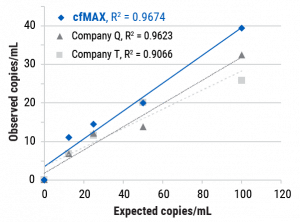
Figure 1. The cfMAX cfDNA Isolation System extracts more cfDNA than other kits. We added known amounts of a synthetic cfDNA to DNA-depleted plasma replenished with 5 ng of sheared genomic DNA and compared cfDNA isolation efficiency of the cfMAX cfDNA Isolation System to two competitor kits. The cfMAX cfDNA kit more consistently and linearly delivered the expected amount of the spiked-in DNA than the competitor kits (n=3 for each data point).
While the existence of cfDNA has been known for almost a century2, it’s only in the past decade or so that researchers have been able to recognize and fully exploit the valuable insights to be gained from analyzing cfDNA. Especially in the fields of oncology and prenatal testing, cfDNA not only serves as a biomarker for disease but can also provide non-invasive information on genetic abnormalities that may be present in in cancer cells3 or the developing fetus.
However, the DNA sequencing and PCR methods used to analyze cfDNA are highly sensitive to even low levels of longer contaminating genomic DNA. And the amounts of cfDNA present in the bloodstream can vary greatly among individuals. As a result, a reliable high yield cfDNA isolation method optimized for short DNA fragments is essential and researchers should choose the cfMAX cfDNA Isolation System.
- Reliably achieve high yields of cfDNA
- Maximize isolation of short DNA fragments while reducing contamination from longer genomic DNA
- Get superior performance compared to competitor kits
- Maximize productivity with the quick and easy magnetic bead isolation workflow
- Suitable for a range of input volumes
- Compatible with both manual and automated isolation workflows
- Interchangeable with MagMAX™ cfDNA isolation kit in Kingfisher systems
- Babji D, Nayak R, Bhat K, and Kotrashetti V. Cell-free tumor DNA: Emerging reality in oral squamous cell carcinoma. J Oral Maxillofac Pathol. 2019 May-Aug; 23(2): 273–279. PMCID: PMC6714275.
- Mandel P, Metais P. Les acides nucleiques du plasma sanguin chez l'homme [in French] C R Seances Soc Biol Fil. 1948;142:241–243.
- Ulrich BC and Paweletz PC. Cell-Free DNA in Oncology: Gearing up for Clinic. Ann Lab Med. 2018 Jan; 38(1): 1–8. PMCID: PMC5700141.
References
How It Works
How It Works
A faster workflow than competitor cfDNA isolation kits
The cfMAX cfDNA Isolation System uses a fast and simple magnetic bead isolation workflow—lyse your serum or plasma sample with the included cfMAX buffer, add beads, immobilize beads with the magnet, wash the beads, and elute cfDNA.
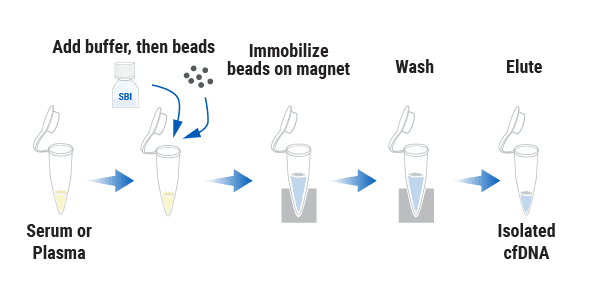
Figure 2. The fast cfMAX workflow. Quick, easy, and high-yield, the cfMAX workflow combines an efficient cfDNA isolation protocol with efficient cfDNA capture.
Supporting Data
Supporting Data
See the excellent performance of the cfMAX cfDNA Isolation System
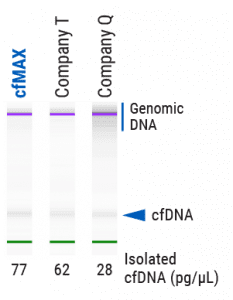
Figure 3. cfMAX delivers cfDNA with less contaminating genomic DNA and higher yields of cfDNA than competing kits. We isolated cfDNA from 2 mL of plasma using the cfMAX System and two competitor kits. The cfMAX system shows less contaminating genomic DNA than the other kits.
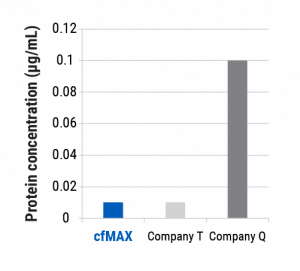
Figure 4. cfMAX delivers cfDNA with less protein carryover than competing kits. We isolated cfDNA from 2 mL of serum using the cfMAX System and two competitor kits. The cfMAX system shows significantly less protein carryover than Company Q's kit, and similar low amounts of protein carryover as Company T's kit, as determined by Qubit Protein Assay.
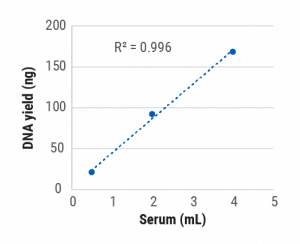
Figure 5. cfDNA isolation with cfMAX is scalable. We isolated cfDNA from increasing volumes of the same serum sample using cfMAX. Isolation is highly linear across the input sample volumes.
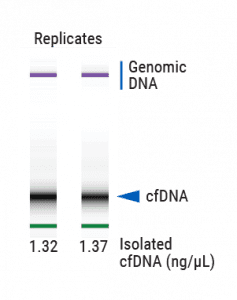
Figure 6. cfDNA isolation with cfMAX is reproducible. We isolated cfDNA from 2 mL of the same serum sample in duplicate using cfMAX. The similar yields demonstrate the reproducibility of cfMAX.
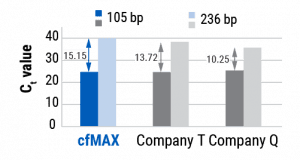
Figure 7. cfMAX is optimized for isolating smaller DNA fragments. Using 105- and 236 bp fragments of GAPDH, we assessed the efficiency of DNA isolation by cfMAX and the other kits from serum. The DNA isolated by the cfMAX kit shows a much larger difference in Ct values than the DNA isolated from the other kits, indicating that the cfMAX kit more preferentially isolates smaller DNA fragments.
FAQs
Documentation
Citations
Related Products
Products
| Catalog Number | Description | Size | Price | Quantity | Add to Cart | |||
|---|---|---|---|---|---|---|---|---|
| CFMAX100A-1 | cfMAX™ cfDNA Isolation System | 1 Kit (processes 80 mL of serum or plasma) | $615 |
|
||||
Overview
Overview
Reliable insights from cell-free DNA (cfDNA) start with high-quality, high-yield isolation
Isolating cfDNA from plasma and serum can be challenging, as the amount of cfDNA present in individual samples can vary widely1 and analysis of cfDNA can be complicated by the presence of even low amounts of longer contaminating genomic DNA. With the cfMAX™ cfDNA Isolation System from SBI, you can overcome these challenges and consistently obtain higher yields of cfDNA than other kits can deliver (Figure 1) with a kit optimized for isolation of short DNA fragments. The result is more reliable downstream analysis and greater insights into disease states.

Figure 1. The cfMAX cfDNA Isolation System extracts more cfDNA than other kits. We added known amounts of a synthetic cfDNA to DNA-depleted plasma replenished with 5 ng of sheared genomic DNA and compared cfDNA isolation efficiency of the cfMAX cfDNA Isolation System to two competitor kits. The cfMAX cfDNA kit more consistently and linearly delivered the expected amount of the spiked-in DNA than the competitor kits (n=3 for each data point).
While the existence of cfDNA has been known for almost a century2, it’s only in the past decade or so that researchers have been able to recognize and fully exploit the valuable insights to be gained from analyzing cfDNA. Especially in the fields of oncology and prenatal testing, cfDNA not only serves as a biomarker for disease but can also provide non-invasive information on genetic abnormalities that may be present in in cancer cells3 or the developing fetus.
However, the DNA sequencing and PCR methods used to analyze cfDNA are highly sensitive to even low levels of longer contaminating genomic DNA. And the amounts of cfDNA present in the bloodstream can vary greatly among individuals. As a result, a reliable high yield cfDNA isolation method optimized for short DNA fragments is essential and researchers should choose the cfMAX cfDNA Isolation System.
- Reliably achieve high yields of cfDNA
- Maximize isolation of short DNA fragments while reducing contamination from longer genomic DNA
- Get superior performance compared to competitor kits
- Maximize productivity with the quick and easy magnetic bead isolation workflow
- Suitable for a range of input volumes
- Compatible with both manual and automated isolation workflows
- Interchangeable with MagMAX™ cfDNA isolation kit in Kingfisher systems
- Babji D, Nayak R, Bhat K, and Kotrashetti V. Cell-free tumor DNA: Emerging reality in oral squamous cell carcinoma. J Oral Maxillofac Pathol. 2019 May-Aug; 23(2): 273–279. PMCID: PMC6714275.
- Mandel P, Metais P. Les acides nucleiques du plasma sanguin chez l'homme [in French] C R Seances Soc Biol Fil. 1948;142:241–243.
- Ulrich BC and Paweletz PC. Cell-Free DNA in Oncology: Gearing up for Clinic. Ann Lab Med. 2018 Jan; 38(1): 1–8. PMCID: PMC5700141.
References
How It Works
How It Works
A faster workflow than competitor cfDNA isolation kits
The cfMAX cfDNA Isolation System uses a fast and simple magnetic bead isolation workflow—lyse your serum or plasma sample with the included cfMAX buffer, add beads, immobilize beads with the magnet, wash the beads, and elute cfDNA.

Figure 2. The fast cfMAX workflow. Quick, easy, and high-yield, the cfMAX workflow combines an efficient cfDNA isolation protocol with efficient cfDNA capture.
Supporting Data
Supporting Data
See the excellent performance of the cfMAX cfDNA Isolation System

Figure 3. cfMAX delivers cfDNA with less contaminating genomic DNA and higher yields of cfDNA than competing kits. We isolated cfDNA from 2 mL of plasma using the cfMAX System and two competitor kits. The cfMAX system shows less contaminating genomic DNA than the other kits.

Figure 4. cfMAX delivers cfDNA with less protein carryover than competing kits. We isolated cfDNA from 2 mL of serum using the cfMAX System and two competitor kits. The cfMAX system shows significantly less protein carryover than Company Q's kit, and similar low amounts of protein carryover as Company T's kit, as determined by Qubit Protein Assay.

Figure 5. cfDNA isolation with cfMAX is scalable. We isolated cfDNA from increasing volumes of the same serum sample using cfMAX. Isolation is highly linear across the input sample volumes.

Figure 6. cfDNA isolation with cfMAX is reproducible. We isolated cfDNA from 2 mL of the same serum sample in duplicate using cfMAX. The similar yields demonstrate the reproducibility of cfMAX.

Figure 7. cfMAX is optimized for isolating smaller DNA fragments. Using 105- and 236 bp fragments of GAPDH, we assessed the efficiency of DNA isolation by cfMAX and the other kits from serum. The DNA isolated by the cfMAX kit shows a much larger difference in Ct values than the DNA isolated from the other kits, indicating that the cfMAX kit more preferentially isolates smaller DNA fragments.

